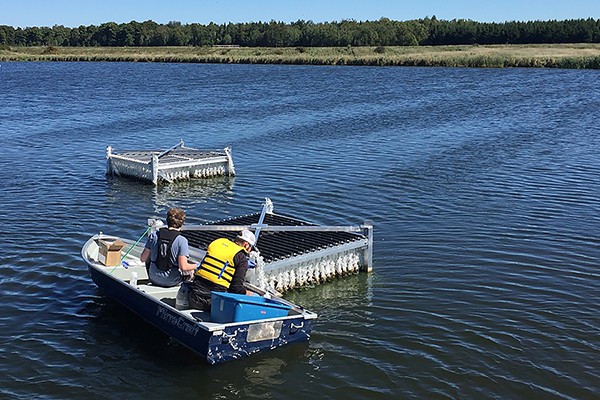 Masters student Adam Skoyles conducts a field sampling with assistance from doctoral candidate Tom Reid.
Masters student Adam Skoyles conducts a field sampling with assistance from doctoral candidate Tom Reid.
A UWindsor research team is studying a municipal wastewater treatment technology that uses naturally-occurring bacteria to remove contaminants from the water efficiently, inexpensively and without chemicals.
Chris Weisener, professor of earth and environmental sciences and member of the Great Lakes Institute for Environmental Research, and GLIER post-doctoral fellow Rao Chaganti are testing a patented technology called a BioCord, created by industry partner Bishop Water Technologies.
Wastewater is full of nitrates and phosphates from detergents, commercial fertilizers and sewage that are flushed into municipal systems. Removing the pollutants is a complicated and pricey endeavour, but if left unchecked, the pollutants act as nutrients spurring growth of plants and algae.
Algae, or cyanobacteria, can choke out native species and release toxic microcystins, which pose a risk to human health; if ingested, algae can irritate the liver, skin, eyes and throat.
The BioCord is a scaffold of synthetic polymer cords that indigenous bacteria will naturally colonize. The microorganisms, already present in the wastewater, will create a biofilm on the scaffold and this multilayered community will remove nitrogen and phosphorous from the wastewater.
“We are taking a natural phenomenon, a naturally-occurring relationship of microorganisms that can process nitrogen, and encouraging their growth in high concentration,” says Dr. Weisener. “The biofilm will then actively metabolize any residual ammonia left in the system.”
He says the technology was successfully tested in a pilot project and his new year-long project is set up in a full-fledged municipal wastewater treatment system. The BioCords are suspended from rafts, with 10 rafts placed in the final of four connected wastewater lagoons in Dundalk, Ontario, as part of the water treatment service for the Township of Southgate.
To understand the true efficiency of the BioCord and biofilm relationship, the study will compare the efficiency of the treatment method in summer and winter months. Specifically, Weisener and his team will look at the how the microbial community functions at a molecular level by looking at which genes are turned on and off from season to season.
“We know the technology works, but our challenge is to find out how the biofilm is affected by seasonal change; from the most optimum growing time in the summer to seeing what changes, if anything, in the efficiency of the microorganism communities when things slowdown in the winter,” he says. “We know that nitrogen cycling organisms can operate well at low temperatures and we want to know to what degree.”
Working with the Dundalk facility allows the researchers to monitor the technology in real-world conditions.
“If we have a success story, this gives Bishop a chance to see their technology adopted elsewhere,” says Weisener. “There are limitless possibilities for any municipality to effectively clean up their wastewater at a fraction of the cost.”
The year-long project started in September 2016. It is funded with an NSERC Engage Plus grant along with funds from Ontario Genomics and Mitacs.
